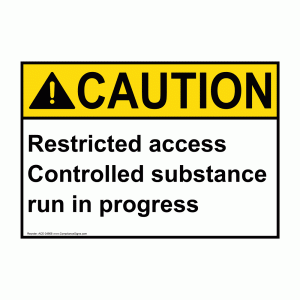
In a recent report, the Department Of Energy’s Office of Inspector General (IG) found issues with the way Los Alamos National Laboratory (LANL) keeps track of controlled substances such as cocaine, fentanyl, and methamphetamine. The IG found that LANL staff had not managed controlled substances in accordance with applicable Federal laws and regulations.
The IG also found that LANL staff had mislabeled procurement records of these drugs, kept inaccurate inventories, and retained controlled substances well beyond the conclusion of experiments. The IG determined that Los Alamos did not have appropriate “processes, procedures, or controls in place to monitor, track, account for, and dispose of controlled substances.”
Drugs and other substances that are considered controlled substances under the Controlled Substances Act are divided into schedules based on whether they have a medical use in treatment, their relative abuse potential, and likelihood of causing dependence when abused. The eight controlled substances identified at Los Alamos included cocaine, codeine, fentanyl, methamphetamine, morphine, sodium pentobarbital, ketamine, and chloral hydrate.
LANL did not have a specific database for controlled substances and, instead, used the Lab’s chemical database, which was not designed or intended to account for controlled substances per DOE requirements. Records of controlled substances were nonetheless managed in this system, which was designed to track chemical containers and locations, not chemical usage.
One controlled substance, fentanyl, was categorized in the LANL procurement system as “Goods” on two separate procurement orders of 50 grams each. Also, 50 grams of fentanyl was added to the chemical database 1 week prior to the initiation of the IG inspection. A 2017 entry only showed 5 grams of fentanyl on hand and did not provide any record of the original procurement of 50 grams.
The IG report continues–
One researcher’s inventory understated the amount of fentanyl on hand. Specifically, the inventory indicated that as of May 7, 2015, 48.5 grams were used for experiments out of the original 50 grams procured; however, on May 8, 2015, the inventory weight indicated that only 45 grams were actually consumed by experiment. This left 3.5 grams of fentanyl not readily accounted for. This occurred despite the researcher having an in-house policy outlining inventory and inventory discrepancy procedures.
The potential for risk was especially evident when inventory errors caused an overstatement in the amount of fentanyl consumed by experiments, leaving an unaccounted surplus. In this instance, the surplus amount created an opportunity for the misuse or loss of a Schedule II narcotic that is increasingly being linked to drug-overdose deaths in the United States. Fentanyl was detected in 56.3 percent of 5,152 opioid overdose deaths in 10 states during July-December 2016. According to the Environmental Protection Agency, fentanyl is 50-100 times more potent than morphine, with a fatal dose of 2 milligrams (0.002 grams) for previously unexposed adults. Based on this lethal dose amount, the loss or misuse of 3.5 grams of fentanyl due to an inventory error has the potential to cause 1,750 deaths.
The IG report stated, “The primary mission at Los Alamos is to solve national security challenges through scientific excellence.” But a major factor in achieving scientific excellence is accurate record keeping. This is where LANL staff has ongoing problems. This should be a place where there are large deductions from LANL’s annual performance award fee. But any deductions from the award fee have to be initiated by the DOE’s Los Alamos Field Office. Let’s hope the Field Office can get LANL’s attention because the IG has no enforcement authority or ability to fine. The IG let LANL off with just requiring the Lab to implement a brand new controlled substances policy, and completing an initial evaluation of the effectiveness of that policy.
Controlled substances are managed under several Federal regulations including a Federal Acquisition Regulation (FAR), which is included the Managing and Operating contactor’s (Triad’s) contract. The FAR stipulates that controlled substances be classified as sensitive property and “subject to exceptional physical security, protection, control, and accountability.”
What was the Lab doing with these controlled substances? Other reports hint that some of these drugs may have been used in chemical warfare agent research and experiments. (See Cyclodextrin-Based Nanometer-Scale Scaffolds for Capture and Catalytic Degradation of Chemical Warfare Agents)
LANL has trouble keeping track of other materials in addition to controlled substances. For instance, the Lab has a history of waste drum tracking issues. In LANL’s Fiscal-Year 2018 Noncompliance Report, Triad National Security, LLC was charged with 6 non-compliances with 20 instances of waste drum labeling problems. This is and ongoing issue, with FY2013 taking the prize with 130 instances of noncompliance associated with container labeling compliance and 24 associated with recordkeeping and reporting requirements.
NukeWatch believes that LANL staff can and should do better. Why is the public continually put at an unnecessary risk? Basically, LANL gets what equipment it asks for. It has some of the biggest computers. Why is it so hard to keep track of chemicals and waste drums? LANL staff needs to prove to Northern New Mexico why the Lab should be allowed to continue operations. And the answer cannot be because everyone who works there gets paid so well.
